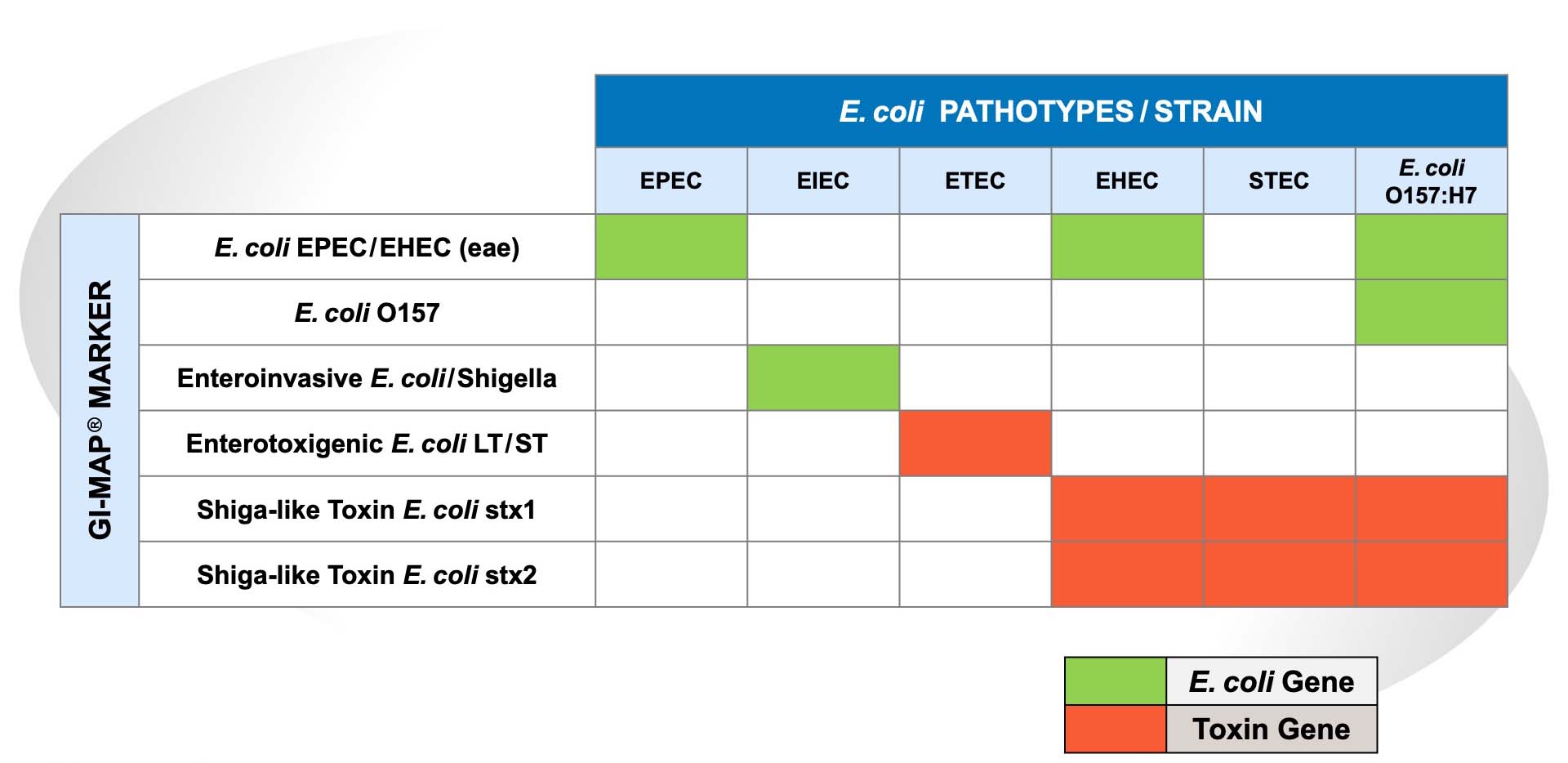E. coli - EPEC/EHEC Update

The E. coli - EPEC/EHEC marker represents an important detail to our testing, allowing for more accurate detection of Enteropathogenic or Enterohemorrhagic E. coli. This modified nomenclature is designed to provide you with more precise and actionable data for better patient outcomes. Here are several key points to understand about this updated line item.
-
E. coli attachment effacement (eae) gene: The E.coli eae gene encodes an attachment protein used for bacterial adherence to enterocytes. This gene can be present in both Enteropathogenic (EPEC) and Enterohemorrhagic (EHEC) E.coli strains. This single gene is quantified in the GI‑MAP® for detection of these two pathogenic strains of E.coli often found in the human GI tract.
-
Two E.coli Strains: The line item indicates that either EPEC or EHEC have been detected in the patient’s fecal sample.
-
Enteropathogenic (EPEC) is a causative agent of infantile diarrhea as well as sporadic adult diarrhea. This non-invasive E.coli strain results in watery diarrhea with rapid onset (few hours post ingestion) with resolution after several days.
-
Enterohemorrhagic (EHEC), often also referred to as Shiga toxin-producing E. coli (STEC) are toxin encoding strains of highly pathogenic E. coli with a wide range of symptoms from mild uncomplicated diarrhea up to severe hemolytic uremic syndrome (complication observed in 5% of pediatric infections).
- There are several EHEC serotypes with E. coli O157:H7 being the most common but also include O26, O, O55, O91, and other serotypes.
- The O157 serotype includes both pathogenic and non-pathogenic E. coli strains. Thus, detection of the O157 serotype does not automatically indicate the presence of EHEC strains.
-
Understanding the difference between these two E. coli strains coupled with detection of both strains provides critical insight into the patient’s infection, clinical risk, and treatment options.
-
-
High Sensitivity: GI‑MAP’s qPCR technology allows for detection of E. coli populations even before clinical infection becomes evident, enabling early intervention.
How to Interpret Your Patient's Results

- If the test shows only E. coli - EPEC/EHEC (eae gene) as present (no other toxins detected): it is likely that your patient has an EPEC strain.
- If the test shows both E. coli - EPEC/EHEC (eae gene) and a toxin (STX1 or STX2): it is likely that your patient has an EHEC strain.
- If test shows a negative E. coli - EPEC/EHEC (eae gene) but a positive toxin (STX1 and/or STX2): it is likely that your patient has an STEC strain.
If you’d like to learn more about the E. coli - EPEC/EHEC line item or any of our other GI‑MAP markers, we invite you to explore the GI‑MAP Essentials course in DSL Academy and our other educational materials.

Amy Rolfsen, ND
Amy Rolfsen, ND, is a distinguished naturopathic physician, seasoned speaker, and dedicated medical educator renowned for her specialization in the intricate realm of the gut microbiome and gastrointestinal health.
In addition to her role at Diagnostic Solutions Laboratory, Dr. Rolfsen operates a thriving private practice, where she extends her services through virtual consultations specializing in lab interpretation, complex gastrointestinal conditions, and pediatric care.
The opinions expressed in this presentation are the author's own. Information is provided for informational purposes only and is not meant to be a substitute for personal advice provided by a doctor or other qualified health care professional. Patients should not use the information contained herein for diagnosing a health or fitness problem or disease. Patients should always consult with a doctor or other health care professional for medical advice or information about diagnosis and treatment.